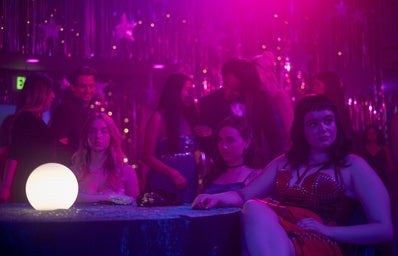Feeling revitalized after a pandemic-induced extended summer, I arrived at UCLA with high expectations. I was bright-eyed and ready for four years of wild parties and exciting adventures. Then I enrolled in my first computer science class, and everything went downhill from there.
In all seriousness, most days of my first two years of college were boring enough to be filtered out of the most mediocre Netflix show, and that is totally normal. In fact, the average college student spends under ten hours a week relaxing and socializing and over 20 hours on school and work related activities. College can be isolating and stressful, and student mental health seems to be reaching a new low with recent studies finding 1 in 3 college students experiences significant depression and anxiety. On top of all of that, a lot of college parties are just stuffy rooms, bad music and cheap alcohol—who wouldn’t be disappointed by that?
“Teen-age girls live in a world all their own… a world of sweaters and skirts… (and) of high school boys.”
LIFE Magazine, December 1944
These realities weren’t reflected on my college mood boards, so now I’m asking myself: how did I end up with such unrealistic expectations?
In many ways, our modern conception of American young adult life is a marketing ploy. Americans didn’t even consider the teen years to be a distinct life stage until the 1940s, when the post-war economic boom and the rise of compulsory education meant that (white, middle-class) young adults had time and money to spend. In 1944, LIFE Magazine wrote “U.S. teen-age girls live in a world all their own… a world of sweaters and skirts… (and) of high school boys.” This misogynistic caricature of teen girls helped to define us as a marketable demographic: “teen-agers” (soon to lose the hyphen) eager to over-consume in a way previous generations could not afford to. Thus, from the 1950s onward, the young adult dream became a product to sell.

Today, young adults are the targets of branding and media that sell identity along with apparel. We are the targets of careful product placement by companies like Juul Labs, investigated for promoting e-cigarettes and nicotine use on websites like girlsgogames.com and collegeconfidential.com. We scroll past Brandy Melville’s posts on Instagram, featuring mostly thin, white girls exuding effortless trendiness. We watch 28-year-old actors play high schoolers who never do homework in Euphoria (while aestheticizing sex, drug use and trauma). We are purposefully being marketed an image of young adulthood that is risky, exclusionary and downright expensive. It’s no wonder that our lives don’t live up to our expectations.
Colleges are businesses, so they are even more overtly (and falsely) marketed than young adult identity. For example, the majority of schools significantly overrepresent diversity in recruitment material images. Even accounts like UCLA Housing on TikTok aren’t immune to false advertising: under this TikTok about UCLA’s dining hall experience, commenter Omar wrote: “I applied to ucla for the food and yet i ended up in the apt with no meal plan😔😔.”
Like Omar, we all don’t always get what we want. College isn’t all fun and freedom, but we can enjoy it for what it is. It’s time that we adjust our expectations and recognize the ways in which media and marketing have manipulated our expectations.



